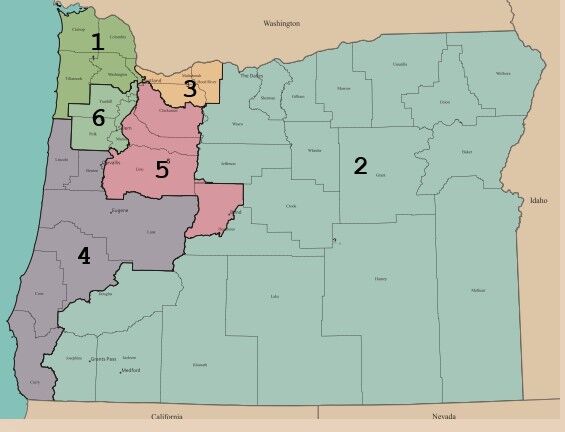Political Notebook: Congress races tighten, GOP fair play, X-filers, IPO picks
Published 3:28 pm Saturday, August 6, 2022

- Final map of the six congressional districts on the 2022 ballot.
Three open congressional seats in Oregon are less firmly in Democratic control, according to a report on Friday. The day also saw a GOP legislative candidate find an innovative ad strategy and the biggest little political party in the state issue its candidate list.
Forecast: Races for three Congress seats tighten
The Cook Political Report, a top national election forecaster, on Friday reported that it was now rating three open congressional seats in Oregon as less of a lock for Democrats in November.
The races are key to which party will control the U.S. House of Representatives after the Nov. 8 election. Democrats currently hold a 220-210 majority, with five vacancies.
The party of a new president has lost seats in the first midterm after their election in the past 100 years, with the exception of 1934 (amid the Great Depression) and 2002 (after the 9/11 terrorist attacks).
The softening of the outlook for Democratic wins in Congress is part of a nationwide trend, according to top political forecast websites. The Cook Political Report, as well as FiveThirtyEight and the Center for Politics at the University of Virginia, say reflects voter dissatisfaction with President Joe Biden and Congress for their handling of a record increase in inflation.
The website rates seats as solid, likely, lean and toss-up.
The Cook Political Report on Friday moved:
• The 4th Congressional District rating from “likely Democratic” to “lean Democratic.”
The retirement of longtime U.S. Rep. Peter DeFazio, D-Springfield created an open seat in the district, which includes Eugene, Corvallis and Roseburg. Labor Commissioner Val Hoyle dropped her re-election campaign to run for Congress instead. She was endorsed by DeFazio and won the Democratic primary.
Hoyle now faces Alek Skarlatos of Roseburg, who has been the recipient of generous national GOP financial aid after giving DeFazio the closest race of his career in 2020.
Though the new political maps increased the Democratic tilt in the district, Republicans in Washington, D.C., have continued to heavily finance Skarlatos’ second bid.
• The 6th Congressional District moved from “likely Democratic” to “lean Democratic.”
Oregon was awarded a sixth congressional district for 2022 due to its population growth. The 6th district, with no incumbent, was placed with the hub in the Salem area.
Rep. Andrea Salinas of Lake Oswego won the Democratic primary and faces Republican Mike Erickson, also from Lake Oswego.
Though the 6th district favors Democrats according to prior precinct-level voting trends, the new boundaries and the lack of an incumbent make forecasting its future political play more difficult.
In order to create the 6th district, the 5th district was pushed east and realigned to run from Portland, over the Cascades, to Bend.
• The 5th Congressional District remains a “toss-up.” The Cook Political Report had previously moved the district from “leans Democratic” to “toss-up.” New district boundaries left incumbent U.S. Rep. Kurt Schrader, D-Canby, with less than half of his constituents from the prior alignment.
Democratic activists created an active campaign to oust Schrader over his perceived lack of support for the agenda of President Joe Biden. Terrebonne attorney Jamie McLeod-Skinner won 55% of the vote to Schrader’s 45%. But forecasters saw the loss of a Democratic incumbent as increasing the possibility of Republicans taking the seat.
FiveThirtyEight rates seats as solid, likely, leaning, and toss-up. It has moved Oregon’s 5th district to “leaning Republican,” while the 4th and 6th remain as “likely” Democratic – a stronger rating than The Cook Political Report.
“Sabato’s Crystal Ball” – the nickname for the University of Virginia’s political prognostication site leader, Larry Sabato, has a rating range of safe, likely, leaning and toss-up. It has the 5th as a “toss-up” and the 4th and 6th as “likely” Democratic.
Oregon Democrats say the forecasts do not take into account the deeply conservative GOP candidates who won the primaries, particularly following the U.S. Supreme Court ruling overturning Roe v. Wade abortion rights. The GOP candidates, Democrats say, will not appeal to swing voters in a traditionally Democratic-tilting state.
During redistricting, majority Democrats in the Legislature drew political maps that were opposed by Republicans.
Kyle Kondik of the University of Virginia Center for Politics was among independent analysts who said the maps were drafted to ensure Democrats would likely win five of the six seats.
Two districts — the 1st Congressional District in northwestern Oregon held by U.S. Rep. Suzanne Bonamici, D-Beaverton, and the 3rd Congressional District centered on Portland held by U.S. Rep Earl Blumenauer, D-Portland — are considered overwhelmingly Democratic seats.
The 2nd Congressional District seat of U.S. Rep. Cliff Bentz, R-Ontario, is prohibitively Republican. It takes in nearly all of Eastern, Central and Southwestern Oregon.
Of the other three districts, Kondik said the 4th and 6th were strongly Democratic-leaning, while the 5th district was sufficiently Democratic that the party would be able to hold the seat as overall demographics in the Deschutes County area added more Democratic-voting transplants from other parts of the country for future elections.
Legislative candidate spends big for fair sponsorship
Bend Republican Michael Sipe took an unusual campaign advertising step in his bid for House District 53. Along with the usual digital ads on Facebook and television commercial buys, Sipe paid $25,000 to be one of the “title sponsors” of the Deschutes County Fair and Rodeo this weekend.
Sipe is seeking to win the seat currently held by Rep. Jack Zika, R-Redmond. Major population growth and an influx of Democratic voters have shrunken the boundaries and changed the demographics of the district. It has gone from favoring Republicans to a slight Democratic tilt, according to maps filed with the Oregon Legislature last fall. Zika opted not to run for re-election.
Sipe will face Bend attorney Emerson Levy, the Democratic nominee, in November. Levy mounted an energetic campaign against Zika in 2020 before the district was shorn of Republican enclaves such as Sunriver. Zika defeated Levy 57% to 43%.
The political “X-Filers”
The Secretary of State has reported that 10 candidates for the Legislature have qualified as write-ins for the November general election. The largest number are officeholders or candidates of one party who received enough write-in votes to also be listed with another party. Among the “X-filers” is Rep. Bobby Levy, R-Echo, who can also be listed as a Democrat on the ballot. Same for Rep. Mark Owens, R-Crane, Rep. Greg Smith, R-Heppner, and Rep. Christine Goodwin, R-Canyonville. Flipping the political cross-pollination the other way is Sen. Floyd Prozanski, D-Eugene, who qualified to also receive the Republican line under his name.
IPO picks its election line-up
Oregon’s largest minor party has rolled out its list of 51 nominees for the 2022 election. The Independent Party of Oregon – often called by its initials, IPO – counts 137,790 registered voters. It’s list mostly cross-nominated Democrats, including U.S. Sen. Ron Wyden, D-Oregon.
Republican Sen. Bill Kennemer, R-Oregon City, was cross-nominated in Senate District 20. He’s being challenged by Rep. Mark Meek, D-Gladstone, who is looking to move over to the Senate.
“We cross-nominated two other Republicans – Mark Owens in House District 60, who is unopposed in any case, and John Velez in Senate District 13,” said IPO co-chair Andrew Kaza of Redmond, co-owner of the Sisters Movie House.
Owens’ district is the largest by area in the state, taking up most of the southeastern quarter of Oregon and stretching from the Idaho and Nevada borders to as far west as southeastern Deschutes County. Velez is running against Democrat Aaron Woods, a retired information technology executive from Wilsonville.
Alistair Firmin, a Lake Oswego Republican running in House District 38, was also added to the IPO nominee list. He’s up against Democrat Daniel Nguyen, also from Lake Oswego.
The cross-nomination allows candidates to list both their original party and the IPO on the November ballot. As the self-proclaimed “centrist” party, the IPO cross-nomination is sought by some major party candidates as a symbolic of being the less partisan choice in a race.
The November ballot will feature three open congressional seats.
Kaza said the IPO caucus voted to endorse McLeod-Skinner in the 5th district and Salinas in the 6th district.
As for Democratic nominee in the 4th district?
“Val Hoyle did not seek our nomination,” Kaza said. “You’ll have to ask her camp why. But, obviously she is a very partisan Democrat, so maybe that factored in?“





